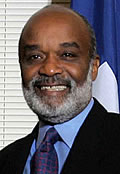History of the Tainos
< Previous | Home | Next >
The Taino society was basically a very gentle culture.
It was characterized by happiness, friendliness and a highly organized hierarchical, paternal society.
Each society was a small kingdom and the leader was called a cacique.
The caciques were singled out for unique housing.
Their houses were rectangular and even featured a small porch.
The round houses of the common people were also large.
Each one had about 10-15 men and their whole families.
Thus any Taino home might house a hundred people.
People slept in cotton hammocks or simply on mats of banana leaves.
They also made wooden chairs with woven seats, couches, and built cradles for their children.
A typical Taino village contained a flat court in the center of the village which was used for ball games and various festivals, both religious and secular.
Houses were around this court.
This was a Each cacique was paid a tribute (tax) to oversee the village.
The Taino diet centered around meat or fish and birds, ducks and turtles as the primary source of protein.
The Tainos developed a system of agriculture which was virtually maintenance free. They raised their crops in a conuco, a large mound which was devised especially for farming.
The Tainos grew corn (maize), squash, beans, peppers, sweet potatoes, yams and peanuts.
They raised tobacco and enjoyed smoking.
They also had cotton.
Their primary crops was cassava which they baked into a bread like slab. The Tainos used dugout canoes which were cut from a single tree trunk and used with paddles.
They could take 70-80 people in a single canoe and even used them for long travels on the sea. The Taino had some weapons which they used in defense.
They used the bow and arrow, and had some poisons for their arrow tips and some spears with fish hooks on the end. The also had a war club made of macana.
This was about 1" thick which is the same as the cocomaque stick used later by Haitians.
The Tainos were polytheists and their gods were called ZEMI. The zemi controlled various functions of the universe.
There were three primary religious practices: Religious worship and obeisance to the zemi themselves.
Dancing in the village court during special festivals of thanksgiving or petition.
Medicine men, or priests, consulting the zemi for advice and healing.
This was done in public ceremonies with song and dance.
There was an afterlife where the good would be rewarded.
They would meet up with dead relatives and friends in the afterlife.
There is a great debate as to just how many Taino inhabited Hispaniola when Columbus landed in 1492. Some of the early Spanish historian/observers claimed there were as many as 3,000,000 to 4,000,000. In 1970 the population was estimated at 8,000,000.
Today there are no easily discerned traces of the Tainos at all except for some of the archaeological remains that have been found.
The Tainos, a discernible people with a discernible culture simply disappeared on the island of Hispaniola present day Haiti and Dominican Republic.
Complete genocide was practiced on these natives.
Claude, March 20 2008, 3:15 AM
Start a NEW topic or,
Jump to
previous | Next Topic >
< Previous | Home | Next >
< Previous | Home | Next >

 Rene Preval and Mahmoud Ahmadinejad
Rene Preval and Mahmoud Ahmadinejad  Rene Preval and Stephen Harper, Canada Prime Minister
Rene Preval and Stephen Harper, Canada Prime Minister  Presidents Rene Preval, Raul Castro, Daniel Ortega, and Leonel Fernandez
Presidents Rene Preval, Raul Castro, Daniel Ortega, and Leonel Fernandez  Rene Preval and Hugo Chavez
Rene Preval and Hugo Chavez  Rene Preval and Peter MacKay
Rene Preval and Peter MacKay  President Rene Preval
President Rene Preval  President Rene Preval
President Rene Preval  President Rene Preval and Hillary Clinton
President Rene Preval and Hillary Clinton  Rene Preval and Josette Sheeran
Rene Preval and Josette Sheeran  Rene Preval and Georges W. Bush
Rene Preval and Georges W. Bush  Rene Preval Sworn In As Haiti's New President, Jeb Bush
Rene Preval Sworn In As Haiti's New President, Jeb Bush  Woman Chosen As Haiti Prime Minister Nominee
Woman Chosen As Haiti Prime Minister Nominee  Bringthepai Preval Pawol Tafia
Bringthepai Preval Pawol Tafia  President Rene Preval speaks to Al Jazeera about the reconstruction of...
President Rene Preval speaks to Al Jazeera about the reconstruction of...  President Fidel Castro Hosts Haiti President-elect Rene Preval
President Fidel Castro Hosts Haiti President-elect Rene Preval 

